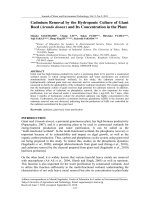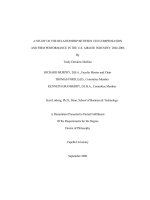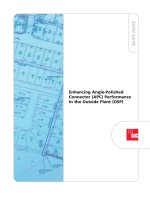Endface Geometry and Connector Reliability in the Outside Plant
Bạn đang xem bản rút gọn của tài liệu. Xem và tải ngay bản đầy đủ của tài liệu tại đây (601.25 KB, 12 trang )
PON Deployment of Angle
Polished Connectors:
Endface Geometry and Connector
Reliability in the Outside Plant
WHITE PAPER
Abstract: Recent wide-scale deployment of APC connectors in the outside plant for FTTH
initiatives has forced connector manufacturers to consider reliability issues of these
connectors. Angled connectors exhibit two phenomena not found in non-angled
connectors: First, the lower ferrule endface radius of angled connectors makes the
connector more susceptible to permanent fiber withdrawal at elevated temperatures.
Second, any rotation of the ferrule in angled connectors will increase the apex offset of the
connector. These phenomena may result in loss of physical contact between the fibers of a
mated connector pair. This air gap may increase reflectance and insertion loss, reducing
system reliability. The air gap may also allow contaminants to migrate on the fibers. Ferrule
rotation and permanent fiber withdrawal need to be minimized for acceptable connector
performance in the outside plant.
©2005 Optical Society of America OCIS codes: (060.2340) Fiber optic components
Introduction
Angled physical contact (APC) fiber optic connectors with zirconia ferrules have
become the de facto standard in PON networks currently being deployed for FTTH
initiatives. The angle on the fiber in APC connectors produces low back reflections
when the connector is not mated to another connector: Reflected light is directed
into the fiber cladding because the endface angle is greater than the acceptance
angle of the fiber. The low reflection of an unmated APC connector provides an
advantage for PON networks: A connector in the PON will usually remain unmated
until service is required from that circuit. This results in unused connectors emitting
their signal into air, which can produce Frensel reflections as high as –14dB for
connectors without an angle on the endface. Service providers need to minimize
system reflections so it won’t interfere with OLT card operation. One solution is to
use non-angled connectors and mate all unused connectors to a terminator. This
solution adds cost because terminators are an additional component. Using APC
connectors provides a cost-effective method to greatly reduce reflection issues
caused by unmated connectors in the PON. Using APC connectors eliminates the
need for terminators because the reflectance of unmated APC connectors is less
than -50dB.
PON Deployment of Angle Polished Connectors:
By Steven C. Zimmel
Endface Geometry and Connector Reliability
in the Outside Plant
Endface Geometry and Connector Reliability in the Outside Plant
Page 3
FTTH deployments are expected to install millions of APC
connectors into outside plant environments over the next
several years. Up to this point, APC connectors have been
primarily used for central office and testing applications.
The upcoming large-scale deployment of APC connectors
in the outside plant forces us to think about some of the
issues that are unique to APC connectors in extreme
environmental conditions. This paper will consider two of
these issues. First, it is necessary to understand the
importance of connector ferrule endface geometry.
APC Endface Geometry and Outside
Plant Reliability
APC connectors provide two benefits. First, APC
connectors produce fiber-to-fiber contact in mated
connector pairs. Physical contact between fibers in mated
connectors is needed because it prevents air gaps from
forming between optical fibers. Air gaps cause increased
reflectance and inconsistent insertion losses that will
reduce system performance and reliability. In addition,
physical contact prevents contamination from migrating
onto the fiber cores. The second benefit of APC
connectors is that they minimize reflectance. If the radius
is polished at an angle such that the angle of the fiber is
greater than the fiber’s angle of acceptance, reflected light
will be directed into the cladding. Using this method, one
can produce connectors with reflectance in the
–50dB range when unmated and as low as -80dB or better
when mated.
Physical contact is realized by polishing a radius onto the
ferrule containing the potted optical fiber and by polishing
the fiber such that it is close to level with the ferrule
surface. The key for physical contact to occur is to center
the apex of the radius over the optical fiber. If the apex is
approximately centered on the fiber, physical contact is
guaranteed because the fibers will be the first objects to
contact each other when connectors are mated.
The parameters used to describe the endface of an APC
connector are radius, apex offset, fiber height, and
endface angle. These parameters are defined in the left
side of Figure 1. Fiber height is the distance the fiber
protrudes or recesses from the ferrule. If the fiber is
recessed too far into the ferrule, obvious air gaps will
occur. Apex offset of an APC connector is the distance
from the apex of the polished ferrule radius to the center
of the fiber core when the endface is viewed at and an
angle of 8° (viewed perpendicular to the plane of the
angled surface). If the apex offset becomes too large, an
air gap will develop because the high point of the ferrule
on the radiused endface will be too far away from the
fiber core per the right side of Figure 1. The endface radius
is applied to the ferrule by polishing the connector on a
compliant surface. If the radius becomes too large, the
ferrule will become effectively flat. This situation could
cause local concave features that will introduce a gap
between the fiber. The radius is usually applied at an 8°
angle. The angle is in a plane that is 8° from perpendicular
to a plane that intersects the connector key. 9° connectors
are used, but are rare.
APC endface geometry parameters are specified such that
physical contact will be maintained over a large range of
operating conditions. For example, at high temperatures,
pressure on ferrule endfaces caused by the spring in the
connector may cause the fibers to permanently withdraw
into the ferrule if the epoxy holding the fibers creep. If the
initial fiber height is too recessed into the ferrule, the fiber
may creep too far back into the ferrule causing loss of
physical contact. Proper specification of these endface
parameters is necessary to guarantee physical contact in
the outside plant.
Apex of the Radius
when viewed at 8˚
Apex offset
Optical Fiber
Fiber Height
Air Gap
Endface Radius
Fig 1. Endface Geometry of an APC Connector and of Two Mated APC Connectors
Several industry standards exist that address APC
connector endface geometry. The purpose of these
specifications is to guarantee that physical contact
between different vendor’s connectors will not be lost. The
most used standards are IEC-60874-14-6 and Telcordia
GR-326, Issue 3. These documents require apex offset to
be less than 50 microns, radius to be from 5mm to 12mm,
and fiber height to be ±100nm. These three requirements
will allow physical contact to be maintained at
temperatures as high as 85°C with proper epoxy selection.
The IEC is in process of updating endface requirements for
APC connectors. The new requirements will reflect current
ferrule material properties and will tie all three properties
together into one function. The new requirements are
expected to be published in 2005.
The preceding discussion shows that proper ferrule
endface geometry is required for good system
performance. Properly specified endface geometries
guarantee physical contact between fibers in mated
connectors. Physical contact is needed so air gaps don’t
form between fibers in connectors, which will cause
increases in reflectance and insertion loss, reducing system
performance. Now that endface geometry and the
importance of physical contact have been defined, we can
discuss issues concerning these properties in APC
connectors in the outside plant.
The effort to maintain physical contact in APC connectors
deployed in the outside plant has two unique challenges
not present in non-angled connectors: First, APC
connectors are much more prone to large permanent fiber
withdrawals when exposed to high temperatures. If the
fiber withdraws too much, physical contact can be lost.
Second, ferrule rotation can create air gaps because of the
angle of the endface. These phenomena must be
accounted for to guarantee proper connector
performance and reliability in the outside plant.
Permanent Fiber Withdrawal, Radius,
and Ferrule Cleanliness:
One manner that fiber height can change, causing fibers
to lose physical contact, is if the fiber permanently
withdrawals into the ferrule. This phenomenon occurs
when mated connectors are exposed to elevated
temperatures. The force on mated ferrule endfaces
transmits pressure to the fiber that is held in place with an
epoxy. This pressure may cause the epoxy and fiber to
creep back into the ferrule at elevated temperatures. If the
pressure is greater than the epoxy bond strength, the
creep will not recover and the fiber/epoxy will permanently
withdraw into the ferrule inside diameter. Figure 2 shows
an electron microscope scan of an connector before (left)
and after (right) GR-326 environmental testing. The region
on the left is the optical fiber, the region on the right is the
ferrule, and the thin section in the middle is the epoxy.
Notice how the fiber is lower than the ferrule in the right
photo. This is the phenomenon of permanent fiber
withdrawal.
It has been observed that permanent fiber withdrawal is
significantly larger in APC connectors than non-angled
connectors that are subjected to GR-326, Issue 3
environmental testing. We routinely observed APC
connectors start a GR-326 test with a protruding fiber and
finish with fibers recessed to a point that it no longer
meets the –100nm requirement. However, we rarely see
this occur in non-angled connectors. The question we
must ask ourselves is why do APC connectors permanently
withdraw so much more than non-angled connectors?
Before we answer that question, we need to determine
which of the GR-326 tests causes the withdrawal.
An experiment was performed to determine which GR-
326 environment causes the most permanent fiber
withdrawal. The experiment consisted of six groups of 12
mated connector pairs (24 APC/SC connectors mated in
12 receptacles). Each group was subjected to either one
week of one of the four GR-326 environmental tests, a
–40°C cold age test, or an ambient age as a control group.
The connectors were measured for endface geometry
using an interferometer, mated together in an adapter,
and subjected to one week of one of the tests listed
above. After 1 week the connectors were removed from
the chambers and allowed to rest at room temperature for
one day. Next the connectors were uncoupled and the
endface geometry was measured. The average, maximum,
and minimum permanent changes in fiber height are
shown in Table 1.
Endface Geometry and Connector Reliability in the Outside Plant
Page 4
Table 1 shows that thermal age and humidity age induced
the most average withdrawal and produced the highest
extremes. Interestingly, the sample that went through
thermal cycle saw less change than thermal age. Even
more interesting is that –40° age showed very little
change. Prolonged exposure to elevated temperatures
induces the most fiber height change. This is evident from
the fact that the tests that spend the most time at high
temperatures (thermal and humidity age) exhibit the most
change. Thermal and condensation cycles are exposed to
high temperatures, but only for 1/8 of the test cycle.
However, even though the cycling tests show far less
change, there is still a significant amount of withdrawal.
This indicates that even short exposures to elevated
temperatures may cause the fiber to withdraw in APC
connectors.
Experiments were then conducted to determine what
specifically about APC connectors induces more
permanent fiber withdrawal than non-angled connectors.
Non-angled (UPC) and angled connectors (APC) differ in
two major ways: First, APC connectors have an endface
radius of 5mm to 12 mm and UPC connectors have an
endface radius of 10mm to 25mm. These endface radii are
defined in IEC and Telcordia standards. The smaller radius
in APC connectors will cause the pressure on the fiber to
be higher because the spring force is spread out over a
smaller contact area. This higher pressure may cause the
fiber to creep more during GR-326 testing. Second, many
APC connector manufacturers perform a secondary
grinding operation of the ferrule to change the chamfer to
geometries that aid in achieving low apex offsets. This
operation is done before the ferrule is potted and may
introduce contaminants to the ferrule I.D.
The experiment looked at two factors: Radius and ferrule
I.D. cleanliness. APC connectors were made with radii of
5-7 mm, 9-11mm, and 18-22 mm. Ferrule inside
diameters were either used as provided or cleaned with a
steam bath and acetone. The sample allocations for the
experiment are shown in Table 2. Groups are not equally
sized because the data represents a summation of three
separate experiments evaluating the same two
parameters.
Endface Geometry and Connector Reliability in the Outside Plant
Page 5
Group 1: Group 2: Group 3: Group 4: Group 5: Group 6:
Thermal Thermal Humidity Condensation Cold Temp Ambient
Age Cycle Age Cycle Age (Control)
Average -109.9 nm -71.0 nm -164.3 nm -129.8 nm -42.8 nm -0.2 nm
Maximum -61.2 nm -14.6 nm -108.1 nm -31.7 nm -34.7 nm -3.7 nm
Minimum -104.9 nm -15.7 nm -291.3 nm -23.6 nm -62.6 nm -4.5 nm
Table 1: Permanent Fiber Height Withdrawal for Various GR-326 Environments
Fig 2. Above: SEM Scan of a Non-Withdrawn APC Fiber
Below: SEM Scan of a Permanently Withdrawn
APC Fiber









